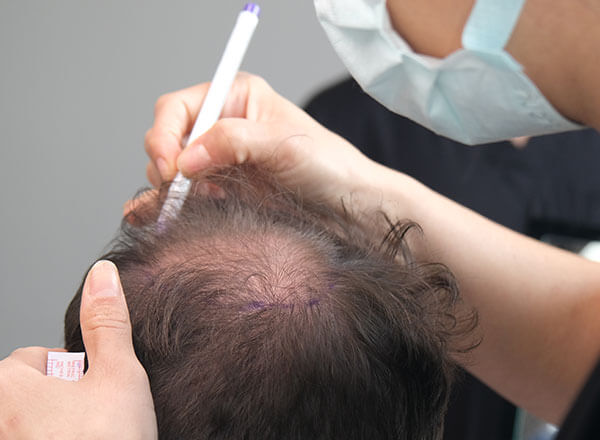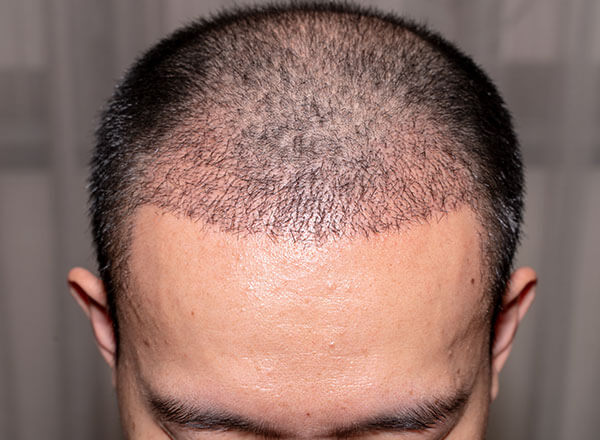


Follicular Unit Extraction (FUE) is an incredibly effective hair transplant procedure for those experiencing hair loss. Unlike traditional methods that involve cutting a strip of hair from the scalp, Follicular Unit Extraction utilizes a small patent-pending instrument to carefully extract individual hair grafts from the donor site, which are then seamlessly transplanted onto the scalp. FUE involves making tiny circular incisions around the upper part of the follicular unit, allowing for the direct extraction of hair grafts without leaving a linear scar. While a few scattered circular scars may remain in the donor area, they are minimal in size and hardly noticeable.

FUE hair transplant remains ideal and beneficial for patients who:
When it comes to the extraction and removal of follicular units from the scalp, every patient has a unique response. While some individuals might encounter damaged hair follicles, others may experience a low transaction rate. Additionally, the nature of one's hair can greatly influence the process. For instance, straight hair tends to be more straightforward to extract compared to curly hair.
At MHTA, we follow a three-step or two-step technique to perform the FUE hair transplant with utmost professionalism and perfection.
Side Effects
Buried Grafts - Some people may develop grafts that get buried beneath the epidermis, causing a cyst. In such circumstances, pressure will be applied to the nearby skin, or a small incision is made to widen the opening to remove the buried grafts.
Capping - Some people may experience capping during the extraction process. Capping is when the epidermis and dermis get detached from the rest of the follicle. Nevertheless, our surgeon will grab and extract the lower portion of the graft. In cases where extraction becomes infeasible, the lower portion is left undisturbed, and rest assured, new hair will grow.
This method not only saves precious time but also has the potential to generate an abundance of follicular grafts. Dr. John Diep uses a meticulously designed instrument specifically crafted for the FUE hair transplant surgery. This tool minimizes the risk of transection (damaged hair follicles).
Side Effects
Patients undergoing the two-step technique may also experience capping and buried grafts.

FUE hair transplant offers substantial benefits, including:
At Medical Hair Transplant and Aesthetics, we understand that hair loss or receding hairlines not only spoil your look but also impact your self-esteem and confidence. That’s why we offer the latest and minimally-invasive hair restoration technique called Follicular Unit Extraction (FUE) that produces natural-looking results with little to no discomfort and scarring.
Dr. John Diep, specializes in performing the FUE technique for all hair types, including both straight and curly hair. He will get to know the degree of your hair loss and the characteristics of your hair and tailor the procedure accordingly, ensuring desired results with utmost precision. With his unparalleled expertise and commitment, you can trust that your hair transplant will produce the best possible results.
Looking for a clinic offering best-in-class FUE hair transplants in San Francisco and Las Gatos? Visit us at Medical Hair Transplant and Aesthetics. We are committed to helping you regain the hairline you have been longing for.
Looking for FUE hair transplant in San Francisco and Los Gatos, CA? Contact us today to schedule a free consultation.
Free ConsultationYes, FUE hair transplant is permanent, as the transplanted follicles will continue to grow hair for the rest of your life.
FUE and FUT hair transplants help restore your hair growth, resolving balding or thinning. Both procedures have their unique benefits and risks, with FUE offering minimal scarring and faster recovery, while FUT allows transplanting more grafts in one session but leaves scarring. So, deciding which is better requires a proper understanding of the two procedures, which you can check out here.
Common side effects of FUE hair transplant are:
These side effects (except infection) will subside on their own within a few days of FUE hair transplant surgery.